The pickle plant (Calhounia or Delosperma echinatum) is a fascinating and unique succulent that has gained popularity for its quirky, pickle-like appearance. Known for its fleshy, cylindrical, and green leaves that resemble mini pickles, this plant is a fun and visually striking addition to any indoor plant collection or garden. Not only is it easy to grow and care for, but it also adds a fun touch to any space due to its distinctive look.
In this article, we will explore everything you need to know about the pickle plant: its origin, characteristics, care requirements, propagation, and common uses. We’ll also answer some frequently asked questions to ensure that you can successfully grow and enjoy this delightful succulent in your home or garden.
Table of Contents
What is the Pickle Plant?
The pickle plant is a type of succulent in the Aizoaceae family, native to South Africa. It is often called the “cucumber plant” or “miniature cucumber” due to its unique leaf shape and texture, which closely resemble small, green pickles. The plant grows as a ground cover, and its elongated, cylindrical leaves are covered with tiny, bead-like protuberances, which give the plant its distinctive “pickle” appearance.
While its aesthetic appeal is enough to draw attention, the pickle plant is also easy to care for and thrives in dry, sunny environments, making it an ideal choice for succulent enthusiasts or anyone looking for a low-maintenance, interesting plant to add to their collection.
Characteristics of the Pickle Plant
The pickle plant has several unique features that make it stand out among other succulents:
1. Distinctive Appearance
The most obvious characteristic of the pickle plant is its appearance. The leaves grow in clusters, each shaped like a small, cylindrical pickle or cucumber. These leaves are often bright green, though they can develop a slight yellow or reddish tint when exposed to intense sunlight. The surface of each leaf is dotted with tiny, fleshy, bead-like structures, giving it a textured and bumpy look. This quirky look has made it a favorite among succulent lovers.
2. Compact Growth Habit
The pickle plant is a compact succulent that typically grows to a height of 3-4 inches (7-10 cm) and can spread up to 12 inches (30 cm) in diameter. It’s perfect for smaller spaces, containers, or hanging baskets. Its low-growing nature makes it suitable for ground cover in xeriscaping or in rock gardens.
3. Color and Texture
The leaves of the pickle plant are typically bright green but may take on hues of yellow, red, or orange if exposed to stress or intense sunlight. The beads on the surface of the leaves are a distinctive feature that gives the plant its name and texture. During its flowering period, the plant produces small, white or yellow flowers that are less prominent than the leaves but still add a touch of brightness.
4. Hardy and Low-Maintenance
The pickle plant is known for being hardy and low-maintenance, making it a perfect choice for beginner gardeners or those who don’t have much time to dedicate to plant care. It’s a drought-tolerant plant that thrives in well-draining soil and doesn’t require frequent watering. It also enjoys plenty of sunlight and is resilient to heat, making it a great addition to sunny windowsills or outdoor rock gardens.
How to Care for the Pickle Plant
The pickle plant is known for being relatively easy to care for, but it still requires some basic care to thrive. Here are the essential care tips to keep your pickle plant healthy and happy:
1. Sunlight Requirements
The pickle plant thrives in full sunlight, so it should be placed in a location that receives at least 4-6 hours of direct sunlight per day. If growing it indoors, a sunny windowsill is the perfect spot. The plant can tolerate partial shade, but its growth may become leggy, and it may lose some of its vibrant color. The more sunlight it receives, the more compact and colorful it will be.
2. Soil Requirements
As with most succulents, the pickle plant prefers well-draining soil. It can thrive in sandy, loamy, or cactus mix soil. If growing in a container, ensure that the pot has drainage holes to prevent water from accumulating at the bottom. This is crucial because the pickle plant is susceptible to root rot if the soil retains too much moisture.
3. Watering
The pickle plant is highly drought-tolerant, making it an excellent choice for people who might forget to water their plants occasionally. It prefers to dry out completely between waterings, so it’s important to let the soil dry out thoroughly before watering again. Overwatering is one of the most common mistakes people make when caring for succulents, so be sure to water only when the soil feels dry to the touch.
During the growing season (spring and summer), you may need to water the pickle plant once every 1-2 weeks. In the winter, the plant enters a dormant phase and requires even less water. It’s better to underwater than overwater this plant, as it stores water in its leaves and can survive dry conditions for extended periods.
4. Temperature and Humidity
The pickle plant is native to the arid, sunny climates of South Africa, so it thrives in warm temperatures. It does well in temperatures between 65-85°F (18-29°C). While it can tolerate some heat, it should be protected from frost, as it is not frost-hardy. If you live in a cooler climate, the pickle plant can be grown as an indoor plant or brought indoors during the colder months.
The plant is not particularly demanding when it comes to humidity and will do fine in average household humidity levels. However, it does best in dry, well-ventilated environments, similar to the conditions found in a desert or Mediterranean climate.
5. Fertilization
The pickle plant does not require frequent fertilization. In fact, too much fertilizer can lead to leggy growth. During the growing season, you can feed the plant once a month with a diluted, balanced, liquid fertilizer designed for succulents or cacti. In the winter, reduce or stop fertilizing altogether, as the plant is in a dormant state and does not need additional nutrients.
6. Pruning and Maintenance
The pickle plant does not require much pruning, but you can trim any dead or damaged leaves to keep the plant looking tidy. It’s also a good idea to remove any long, leggy stems to encourage new growth and maintain a compact form. Always use clean, sharp scissors or pruning shears to avoid damaging the plant.
Propagation of the Pickle Plant
The pickle plant can be easily propagated by stem cuttings, making it simple to grow new plants from your existing ones. Here’s how to propagate it:
- Take a Cutting: Use a sharp, sterilized knife or scissors to take a cutting from a healthy stem of the plant. The cutting should be a few inches long and should include a node where new roots can form.
- Let the Cutting Dry: Allow the cutting to dry for a day or two to prevent rot. This step is crucial, as it helps to seal the cut end.
- Plant the Cutting: Once the cutting has dried, plant it in a small pot filled with well-draining soil. Water lightly, and place the pot in a sunny spot.
- Rooting: After a few weeks, the cutting should develop roots. Once it has established a strong root system, you can transplant it into a larger pot or garden bed.
Common Uses for the Pickle Plant
The pickle plant is versatile and can be used in a variety of settings:
- Container Plants: The pickle plant thrives in containers, making it an excellent choice for patios, balconies, or windowsills.
- Rock Gardens: With its compact growth and tolerance for dry conditions, the pickle plant is an ideal plant for rock gardens or xeriscaping.
- Hanging Baskets: Its trailing nature makes it a great choice for hanging baskets or vertical gardens, where its unique leaves can cascade over the edges.
- Indoor Decor: The pickle plant adds an unusual and interesting touch to any indoor space. Its unique shape and vibrant color make it a conversation starter in your home.
- Ground Cover: In mild climates, the pickle plant can be used as a ground cover in dry, sunny garden beds or along pathways.
FAQs About the Pickle Plant
1. Is the Pickle Plant toxic to pets?
No, the pickle plant is non-toxic to both cats and dogs, making it a safe choice for households with pets.
2. Why are the leaves of my Pickle Plant turning yellow?
Yellowing leaves can be a sign of overwatering, poor drainage, or insufficient sunlight. Ensure that the plant is getting enough sunlight and that the soil is well-draining. Also, check that you are not overwatering the plant.
3. Can I grow the Pickle Plant indoors?
Yes, the pickle plant is well-suited for indoor environments, especially if you can provide it with bright, indirect light. Place it on a windowsill or near a sunny spot to ensure it thrives.
4. **How do I know if my **Pickle Plant
** is healthy?** A healthy pickle plant will have firm, bright green leaves with minimal wilting or yellowing. The leaves should also retain their distinct, bumpy texture. If your plant starts to look leggy or the leaves become soft and mushy, it could be a sign of overwatering.
5. Can I propagate my Pickle Plant from a leaf?
While it’s possible to propagate from leaves in some succulent species, it’s best to propagate the pickle plant by stem cuttings to ensure successful rooting.
Conclusion
The pickle plant is a fascinating and easy-to-care-for succulent that adds unique beauty and texture to any space. Whether grown indoors or outdoors, this quirky plant is a perfect addition for succulent lovers and beginners alike. With minimal care and attention, you can enjoy the distinctive “pickle-like” leaves and occasional blooms of this low-maintenance plant for years to come.



